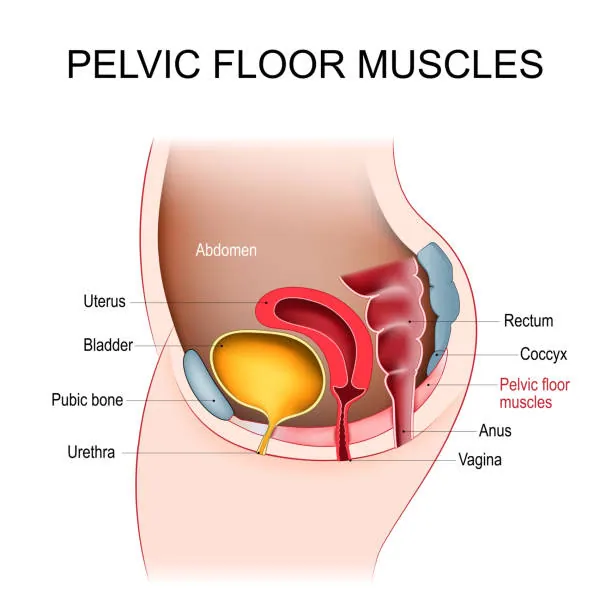Welcome to the guide that will change the way you think about pelvic floor physical therapy. Get ready to revolutionize your approach to pelvic health as we dive into an innovative method that’s transforming lives. Say goodbye to traditional routines and hello to a new era of proactive care.
Discover how frontloading techniques can fast-track your progress and unlock the full potential of pelvic floor therapy. Get ready to embark on a journey towards greater strength, confidence, and well-being.
What Is Pelvic Floor Therapy?

Discover a beacon of hope in pelvic floor therapy for intimate health issues. This approach tackles dysfunction and restores well-being through various techniques. Pelvic floor therapy focuses on optimizing pelvic floor muscles and related structures. It involves exercises, hands-on methods, education, and lifestyle changes. The goal is to ease symptoms, enhance function, and improve the quality of life for those facing pelvic floor issues.
The Pelvic Floor Has Four Primary Functions
Understanding the pelvic floor necessitates acknowledging its multifaceted roles within the human body. This complex system of muscles, ligaments, and tissues isn’t just a passive base. It plays an active role in four vital functions that are really important for staying healthy overall.
- Support: The pelvic floor acts like a strong foundation, holding up and keeping pelvic organs like the bladder, uterus, and rectum in place. It’s crucial to keep these organs where they should be inside the pelvic area.
- Sphincteric Control: The pelvic floor muscles are vital in managing the release of urine and feces. These muscles help us avoid accidents and maintain control. If these muscles don’t work correctly, it can lead to issues like urinary or fecal incontinence, underlining their crucial role in preserving continence.
- Sexual Function: The pelvic floor is a critical player in sexual response and satisfaction. It contributes to arousal, orgasm, and overall sexual well-being. Dysfunction in the pelvic floor can manifest as pain during intercourse or other sexual difficulties, underscoring its significance in intimate health.
- Stability: Apart from supporting organs and controlling bodily functions, the pelvic floor also gives strength to the spine and pelvis. It’s like a strong base that affects your overall posture and muscle stability, showing how it holistically impacts your entire body.
What to Expect
- Thorough Assessment: It all starts with a detailed assessment done by the pelvic floor physical therapist. This might include talking about your medical history, symptoms, and worries, followed by a physical check-up. The goal of the assessment is to pinpoint exact problems so a treatment plan tailored just for you can be created.
- Personalized Exercise Plans: After the assessment, people can expect to have exercise plans made just for them. These exercises focus on particular parts of pelvic floor function, tackling issues like weakness, tightness, or problems. Pelvic floor exercises, often called Kegel exercises, might be included and adjusted to fit each person’s needs.
- Education on Lifestyle Modifications: In addition to exercises, pelvic floor physical therapy often involves learning about lifestyle changes. This could mean getting tips on how to sit, move your body, and use behavioral strategies to make sure your pelvic floor works its best. Making these adjustments in your daily life is essential to keep the benefits of therapy going even after the sessions are over.
- Manual Techniques: Pelvic floor physical therapists often use hands-on techniques. This can involve touching inside or outside the body to release muscle tension, enhance flexibility, and deal with trigger points causing pelvic floor issues. The therapist makes sure you feel at ease and keeps a professional environment during these procedures.
- Open Communication: Talking is a vital part of pelvic floor physical therapy. You can count on having a space where you can openly share your concerns, talk about how you’re doing, and discuss any difficulties you might be experiencing. This open communication creates a teamwork approach, helping you play an active role in your healing journey.
- Gradual Progression: Pelvic floor therapy is not a one-size-fits-all approach. Individuals should anticipate a gradual progression in their treatment plan. As they consistently engage in exercises and implement lifestyle modifications, they may witness improvements in symptoms over time. Patience and commitment are essential elements of this transformative journey.
Self-Care vs Physical Therapy
When it comes to pelvic floor health, many people wonder about the balance between self-care and professional therapy. While self-care is important, knowing the differences between these options is crucial for making intelligent choices about your pelvic health.
Self-Care Practices
Self-care for pelvic floor health usually includes things like Kegel exercises, lifestyle changes, and mindfulness techniques. While these are good for overall pelvic health, they might not be enough for complicated pelvic floor problems. Self-care practices are often general and might not target the specific reasons behind dysfunction.
Pelvic Floor Physical Therapy
On the flip side, pelvic floor physical therapy offers a focused and personalized method for pelvic health. Physical therapists, who are experts in the body’s muscles and bones, do detailed assessments to find exact problems. The treatments they offer are tailored to each person, including exercises, hands-on techniques, and lifestyle changes that tackle the main reasons behind dysfunction.
Delayed Treatment
Putting off pelvic floor physical therapy can affect many parts of your life. Whether you’re unsure, don’t know much about it, or have the wrong ideas, waiting to get treatment can make existing problems worse and lead to more complications.
Potential Consequences of Delayed Treatment:
Understanding the possible results of waiting too long highlights why it’s crucial to seek help early. Pelvic floor physical therapy isn’t just for fixing problems; it’s also about staying ahead of issues and keeping your pelvic health in top shape as you go through different stages of life.
In the following parts, we’ll look into the particular issues tackled by pelvic floor therapy for both women and men. We’ll uncover how pelvic floor problems can affect overall health and dig into the positive changes that can happen when people choose pelvic floor physical therapy.
What Conditions Do You Treat (Female Pelvic Floor)?

Female pelvic floor physical therapy deals with a range of issues specific to women. Here are some common conditions treated through female pelvic floor therapy:
- Pelvic Organ Prolapse: Physical therapy provides techniques to help manage and ease the symptoms linked with pelvic organ prolapse. This condition happens when organs like the bladder, uterus, or rectum drop down into the vaginal canal.
- Urinary Incontinence: Pelvic floor physical therapy helps with different types like stress, urge, or a mix. It works on strengthening and coordinating the muscles that control bladder function.
- Pelvic Pain Disorders: Chronic pelvic pain, dyspareunia (painful intercourse), and other pelvic pain disorders are addressed through a combination of therapeutic exercises, manual techniques, and behavioral strategies.
- Dyspareunia (Painful Intercourse): Pelvic floor physical therapy targets the root causes of painful intercourse. It aims to ease muscle tension, boost flexibility, and enhance comfort during intimate moments.
- Postpartum Issues: The postpartum period brings unique challenges, and pelvic floor physical therapy plays a crucial role in supporting women during this phase.
What Conditions Do You Treat (Male Pelvic Floor)?
Contrary to common beliefs, pelvic floor issues aren’t only for females. Pelvic floor therapy for men deals with various conditions, promoting overall pelvic health and addressing specific concerns unique to male anatomy.
Some common conditions treated with male pelvic floor therapy include:
- Chronic Pelvic Pain: Men can face ongoing pelvic pain, often linked to issues like chronic prostatitis or pelvic floor dysfunction. Pelvic floor physical therapy focuses on the muscles involved, aiming to alleviate this pain.
- Post-Prostatectomy Issues: Prostate surgery, such as a prostatectomy, can lead to pelvic floor dysfunction and urinary incontinence. Pelvic floor physical therapy assists in regaining pelvic floor strength and control post-surgery.
Recognizing that pelvic floor problems can impact everyone, regardless of gender, underscores the need for specialized care.
What Can Dysfunction of the Pelvic Floor Muscles Contribute To?
Pelvic floor muscle issues can affect your health in various ways. Understanding the potential consequences is crucial for realizing the importance of timely intervention. Let’s look at some common effects of pelvic floor muscle dysfunction:
Understanding the more significant impact of pelvic floor issues highlights the importance of getting the right help. Pelvic floor physical therapy stands out as a helpful way to tackle these problems thoroughly.
Benefits of Seeing a Pelvic Floor Physical Therapist
Pelvic floor physical therapists play a crucial role in healthcare but are often overlooked. They provide specialized interventions that go beyond just easing symptoms. Discovering the positive changes from seeing a pelvic floor physical therapist involves exploring subtle improvements that enhance overall well-being.
Improved Pelvic Organ Support
Good pelvic organ support is vital for a healthy pelvic floor. Pelvic floor physical therapy uses specific exercises and hands-on methods to strengthen weak muscles, giving better support to pelvic organs. This is especially important for people with symptoms of pelvic organ prolapse, as it helps improve stability and comfort.
Enhanced Bowel and Bladder Control
Pelvic floor physical therapy empowers individuals by focusing on sphincteric control through targeted exercises. This plays a crucial role in promoting continence. Better coordination of pelvic floor muscles enhances bowel and bladder control, decreasing instances of urinary or fecal incontinence. This improvement helps individuals regain confidence in their daily activities without worrying about unpredictable leaks.
Alleviation of Pelvic Pain
Pelvic pain can really stick around and make life challenging, especially with different pelvic floor problems. However, pelvic floor physical therapy takes a comprehensive approach to ease pelvic pain. It uses specific exercises and hands-on methods and tackles psychological factors to lessen discomfort and improve overall pelvic comfort. This is especially helpful for folks dealing with chronic pelvic pain or pain during sex.
Restoration of Sexual Function
Sexual function is closely tied to pelvic health and pelvic floor physical therapy can make a big difference in bringing back intimacy. It tackles issues like muscle tension, discomfort, and coordination, all of which can affect sexual function. This therapy often leads to less pain during sex, higher arousal, and an overall better intimate life for individuals.
Pre and Postnatal Benefits
Pregnancy and childbirth present unique challenges to the pelvic floor. Pelvic floor physical therapy provides essential support during pregnancy, addressing specific concerns and preparing individuals for childbirth. After giving birth, therapy helps in the recovery of the pelvic floor, encouraging optimal healing and strength.
These prenatal and postnatal benefits make the journey into motherhood smoother, assisting women in regaining pelvic floor strength after delivery. Choosing a pelvic floor physical therapist isn’t just about fixing specific problems; it’s about making significant changes in pelvic health. These experts use personalized treatments, education, and support to help people take charge of their bodies and lives. In the following sections, we’ll share personal stories that show how pelvic floor therapy can be life-changing and answer common questions about this unique type of physical therapy.
Why Going to Pelvic Floor Therapy Transformed My Life

Starting pelvic floor therapy isn’t just a choice; it’s a transformative decision that can profoundly reshape your life. Personal stories often reveal the profound impact of pelvic floor therapy, showing how it can empower, heal, and bring newfound freedom to those who embrace this specialized care.
Two Months Later, I Was on My Way to My First Session
Two months might feel brief, but for those dealing with pelvic floor issues, it can be a crucial period that signals the start of significant change. As I walked toward my first pelvic floor therapy session, a blend of anticipation and curiosity surrounded me. Little did I know that this choice would kick off a series of events reshaping my physical, emotional, and intimate well-being.
The waiting room, with brochures and a calming atmosphere, hinted at an experience beyond typical healthcare. As I sat, thinking about what was coming, a skilled pelvic floor physical therapist welcomed me, soon becoming a guiding force in my healing journey.
In My Next Talk Therapy Session, My Therapist Emphasized the Fact That I Had My First Successful Pelvic Exam
Skipping ahead to my next talk therapy session, the impact was clear. The therapist, known for her empathetic style, highlighted a milestone – my first successful pelvic exam. This seemingly ordinary event became a symbol of triumph over discomfort, a tangible sign of progress that went beyond the physical aspect.
The change wasn’t just physical; it reached into the emotional core of my being. Conquering the stigma linked to pelvic issues, I found a well of resilience within. The open communication encouraged in therapy sessions became a driving force for self-acceptance and newfound confidence.
The Emotional Side Effects Are Also Very Real
Apart from the physical changes, the emotional shift was significant. Pelvic floor therapy isn’t just about treating symptoms; it’s about recognizing the emotional toll that intimate health issues can take. The therapist created a safe environment for me to express myself, helping me navigate the emotional complexities linked to pelvic floor dysfunction.The emotional impact of pelvic floor therapy goes beyond the therapy room, influencing daily life.
The newfound confidence, comfort in discussing intimate concerns openly, and resilience developed throughout the journey are clear signs of emotional healing alongside physical well-being. In simple terms, going to pelvic floor therapy kickstarted a complete transformation. It wasn’t just about fixing symptoms; it was a journey toward empowerment, understanding, and taking back control over my body and life. In the following sections, we’ll answer common questions about pelvic floor physical therapy, giving practical insights into the aspects and considerations of this transformative care.
FAQ More About Pelvic Floor Physical Therapy
Curious minds often harbor questions. Let’s address some common queries surrounding pelvic floor physical therapy.
What Do They Do in Pelvic Floor Physical Therapy?
Sessions typically involve a combination of internal and external assessments, personalized exercise plans, and education on lifestyle modifications to address specific pelvic floor issues.
Do I Need to Shave for Pelvic Floor Physical Therapy?
No need to fret over-grooming. Therapists prioritize your comfort and will work with you regardless of your grooming choices.
What Do You Wear for Pelvic Floor Physical Therapy?
Comfort is key. Wear clothing that allows for easy movement and access to the pelvic region if needed.
How Does a Pelvic Floor Therapist Examine You?
Examinations are conducted with respect and professionalism. Therapists may use internal and external techniques to assess muscle function and identify areas of concern.
Is Pelvic Floor PT Awkward?
Therapists are trained to make you feel comfortable and supported during therapy, even when discussing intimate concerns. They create a non-judgmental environment to ensure your experience is positive and empowering.
How Do You Know If You Need Pelvic Floor PT?
If you experience symptoms like pelvic pain, incontinence, or discomfort during sexual activity, it’s advisable to consult a healthcare professional. They can guide you on whether pelvic floor physical therapy is suitable for your situation.
Conclusion
In the realm of healthcare, pelvic floor physical therapy stands as a beacon of hope for those grappling with intimate health issues. Discover the power of this transformative therapy to take back control of your body and life.
Whether you’re dealing with physical discomfort, aiming to improve intimate well-being, or seeking emotional resilience, pelvic floor physical therapy goes beyond traditional healthcare. It offers a holistic approach to well-being. If you’re unsure, take a step towards a transformed life with pelvic floor physical therapy – where curiosity meets positive change.





